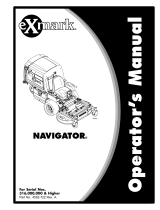
Operation
17
Bagging
T
ips
For best performance, regulate traction speed to keep
engine rpm high and somewhat constant. A good rule
to follow is: decrease ground speed as the load on the
cutting blade increases; and increase ground speed as
load on the blade decreases. This allows the engine,
working with the transmission, to sense the proper
ground speed while maintaining high blade tip speed,
necessary for good quality-of-cut, vacuuming action
and to throw grass into the hopper. If blower speed
drops too low, plugging may result. Refer to Cutting
Unit and Traction Unit Operator’s Manual for
operation of each.
1. Stop engine when emptying hopper to prevent
engine air intake from being clogged with
clippings.
2. Do not collect extremely long grass as the bag
will fill too quickly.
3. The grass collector hopper is designed to exhaust
air through the rear cover. This allows the hopper
to fill completely. Grass will fall through the
chute when the hopper is full. When the hopper
full buzzer sounds immediately disengage the
power take off (PTO) and empty the hopper.
Failure to empty the hopper will plug the chute
and cause clumping on the lawn. After emptying
hopper, check that grass clippings have not fallen
into chute.
4. When bagging wet, heavy grass, some clippings
may not be thrown completely through the
chute. When this happens, reduce ground speed.
5. While operating, check frequently for excessive
clippings left on turf or uncut grass. If those
conditions occur, the blower or cutting unit may
be plugged. Stop unit, disengage PTO, set
parking brake and shut of ignition. Check for
obstructions in the chute, blower or cutting unit.
Clear any obstructions using a stick or similar
tool. Check that screen in hopper is clear of
obstructions. Check blower belt for slipping.
6. Cut grass often, especially when growth is rapid.
If shorter grass is desired, cut the grass again.
Overlap swaths to produce an even cutting
pattern.























